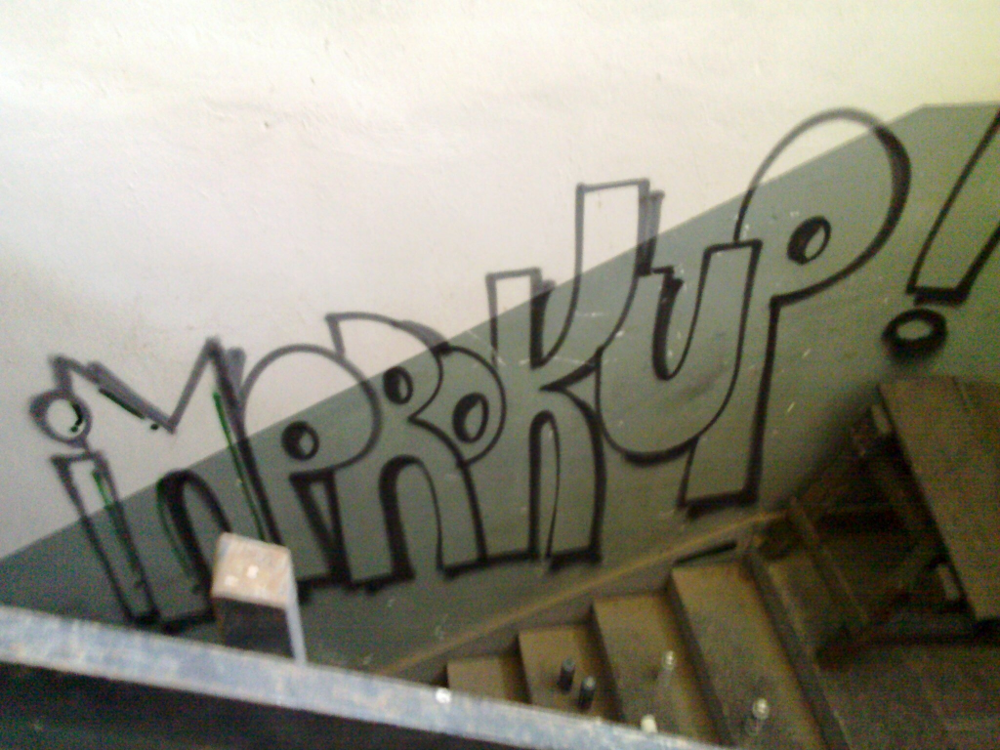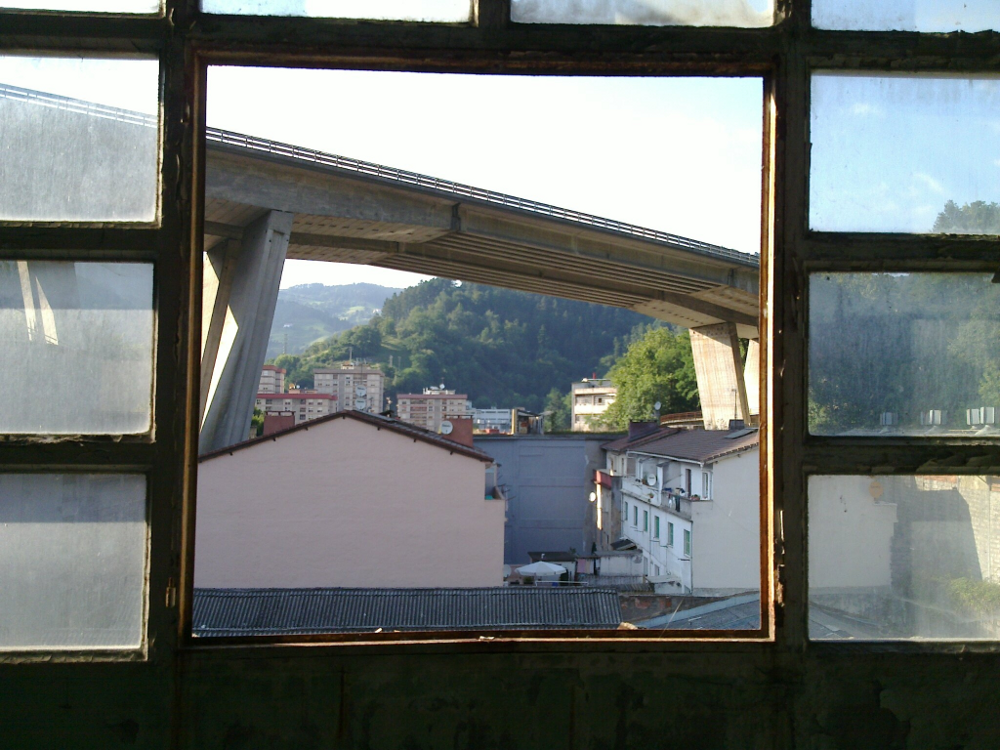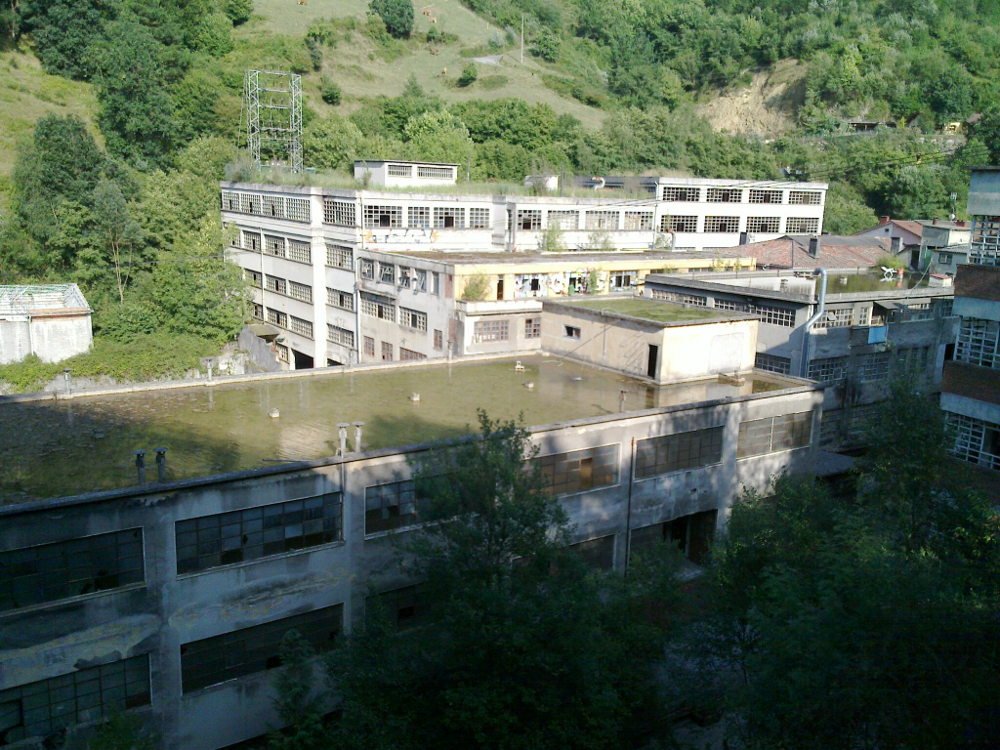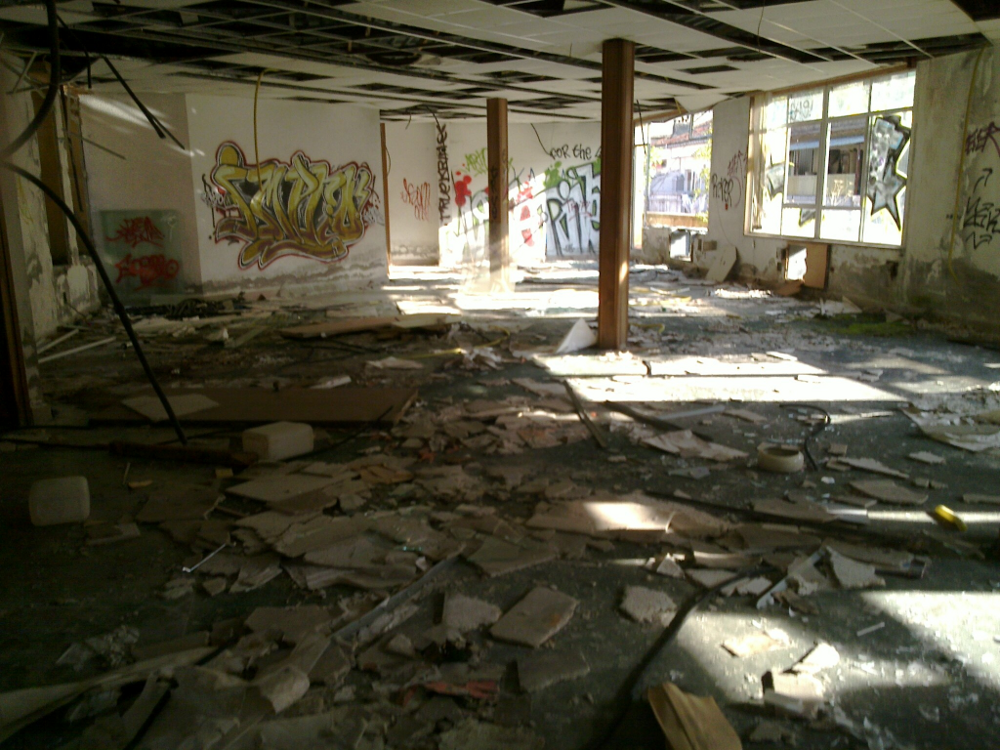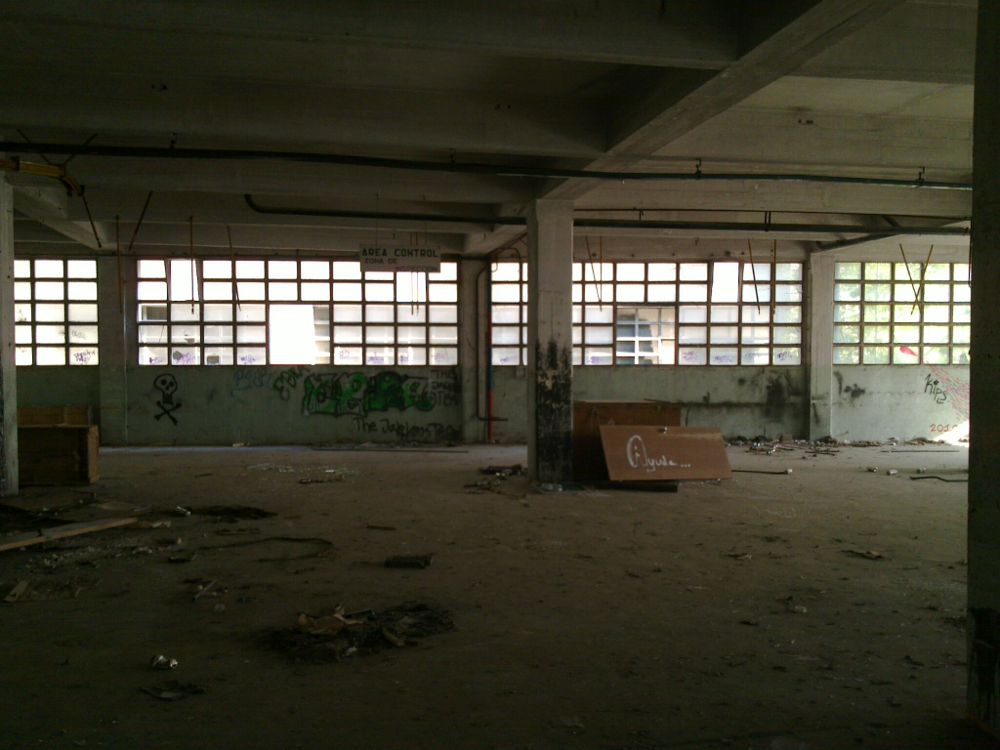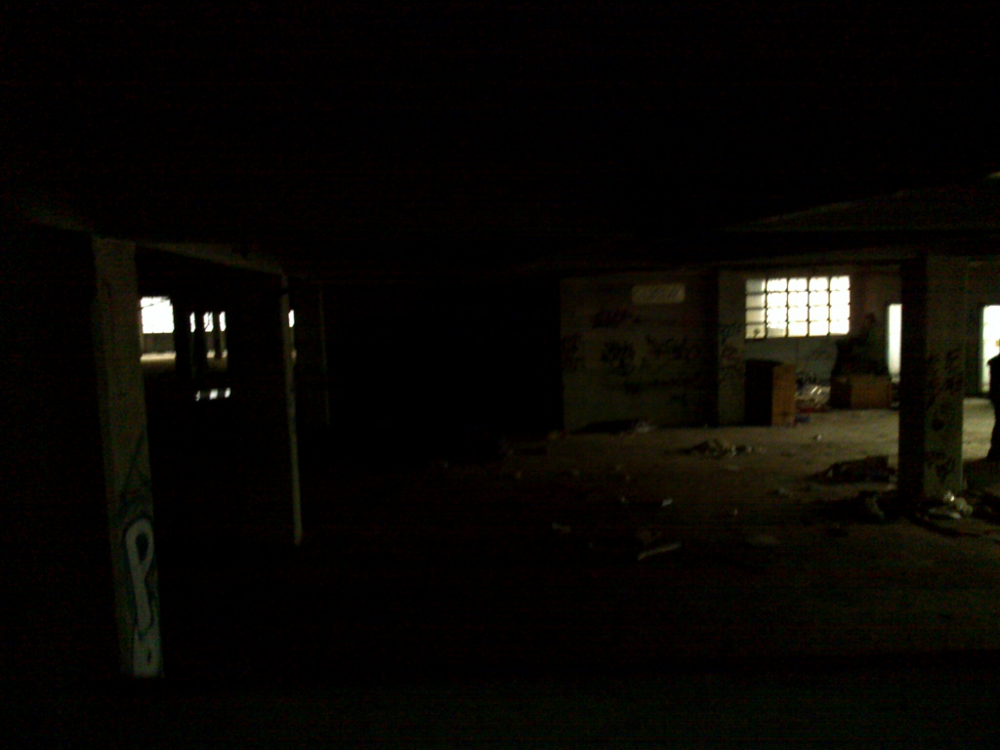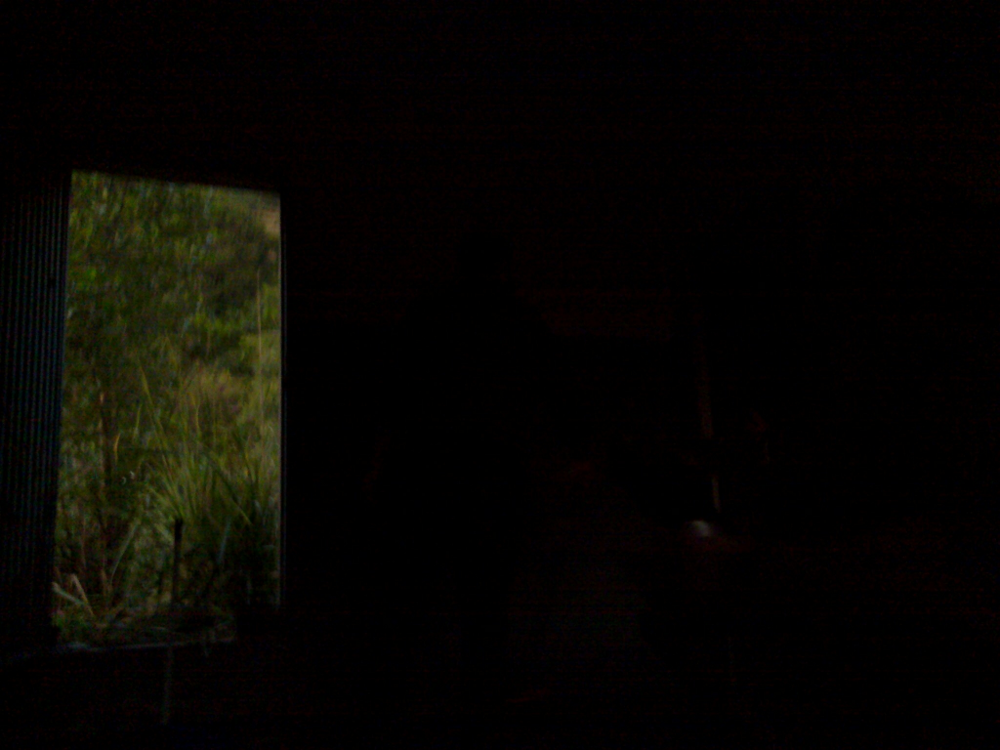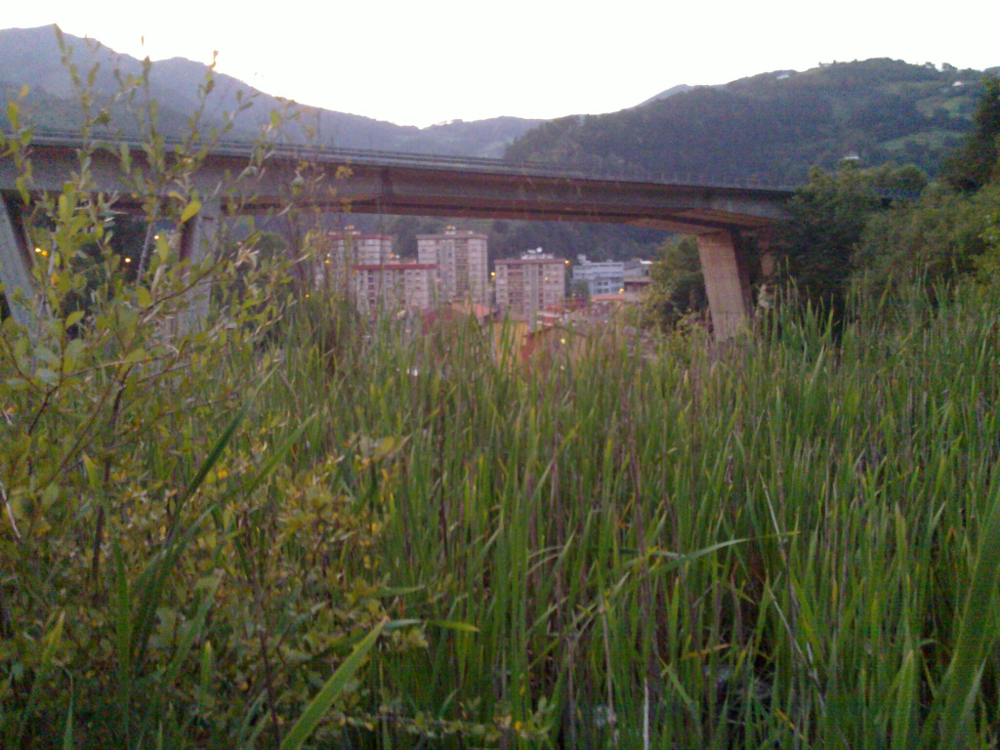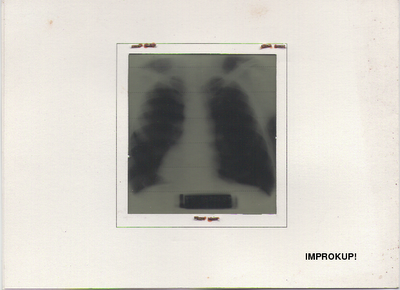THIS IS NOT A PARTY. DON'T BRING YOUR FRIENDS.
DVDR YA ESTA RULANDO, A PARTIR DE HOY Y EN LOS PRÓXIMOS DOS DÍASM SERÁ DIFUNDIDA EN
3 días...
una fabrica abandonada...
el pueblo con las calles más estrechas del universo...
Parece en comienzo de una
película de terror, o el anuncio de una inminente masacre adolescente,
pero no, es el comienzo de una acción experimental dirigida por mattin
y amigos un una fábrica abandonada de Eibar, según un amigo, el pueblo
más feo del mundo...No sé si el más feo, pero desde luego el que tiene
las calles más estrechas que yo he visto y el índice más alto de
edificios deshabitados y/o en desuso y una ínfima e inverosímil
densidad de población.
El motivo de la elección de
la fábrica creo que fue básicamente la accesibilidad y el de la
ocupación y llamamiento a quien quisiera unirse fue el de explorar
diferentes cuestiones como dar una utilidad distinta a un espacio
creado para otra cosa y la inherente interacción con el espacio, o como
la creación de musica/ruido a través de elementos alternativos y
atípicos como los desechos y restos encontrados de la fábrica,
posterior debate incluido.
Una reflexión breve pero
continua sobre uno mismo repecto al espacio, repecto a eso que llamamos
música y respecto a los demás asistentes. Un efímero ejercicio de
exploración y autoconocimiento, de interacción con un espacio nuevo y
ajeno a nuestras costumbres y necesidades diarias y/o un plan
alternativo para el fín de semana. En cualquier caso me gustó la
experiencia y muestro aquí testimonios gráficos, que no sonoros,
lamentablemente, de lo que aquello fue.
Re: [Igua] IMPROKUP DVDR LANZAMIENTO EN STREAMING
Prado Casanova
Wed, 29 Feb 2012 07:48:11 -0800
Hola Aitor, ya lo he leido todo y se me hace corto! llevo un par de
horas con el streaming! dios, estoy flipando, mola mucho mucho mucho.
como hago para conseguir una copia?
hablamos un día de estos por skipe?
abrazos
miguel
From: Loty Negarti:: <aizmad gabone.info>
To: prado <miguel taumaturgia.com>
Subject: improkup!
Date: Wed, 29 Feb 2012 18:17:33 +0000
X-Mailer: Sylpheed 3.0.2 (GTK+ 2.20.1; x86_64-pc-linux-gnu)
aupa miguel,
como
siempre voy tarde con todo, aun ando haciendo las copias pero tranki
que en cuanto tenga os envio a roberto y a ti un par de copias.
me imagino que para la semana que viene tendre unas cuantas asi que en unos 15 dias os podre enviar.
la
verdad es que escucharlo todo de golpe es una experiencia muy extraña,
como estar siguiendo un reality show, un programa de radio, u
observando a unos idiotas en un zoo.
yo
la verdad es que me doy verguenza de mi mismo al escucharme, no callo
ni un puto rato y digo unas paridas a veces que ufff. pero una de las
cosas que nos interesaba era precisamente esa, sacar en crudo todas
nuestras limitaciones (intelectuales, comunicativas, organizativas,
afectivas, etc) y hacerlas explicitas, ponerlas en un primer plano. Es
como diciendo: estos somos nosostros, esto es lo que hay, ¿qué podemos
hacer con esto? ¿que podemos hacer con estas vidas? Tambien esta el
asunto de que fueron tres días muy intensos en un ambito muy privado
donde la intimidad iba creciendo y decimos muchas cosas personales
nuestras y de otras personas... y teniamos la duda de si sacarlo o no,
pero al final decidimos sacarlo. Asi que si la gente lo escucha con
atención a lo mejor tenemos lios con algunas personas... pero bueno, yo
creo que merece arriesgarse.
Tambien
parece como si estuvieras viendo un documental. A mi me da la impresión
de que somos como el de Grizzly Man de la peli de Herzog y que la gente
esta viendonos (en este caso escuchandonos) mientras piensa, ¿pero que
tipo de gente es esta, son idiotas?
Pero ahi esta lo interesante!!!
abrazos!
From: Prado Casanova <miguel taumaturgia.com>
To: fnmaa-12.srv.cat, "Loty Negarti" fnmaa-12.srv.cat: <aizmad gabone.info>
Subject: Re: improkup!
Date: Wed, 29 Feb 2012 19:32:47 +0100
X-Mailer: Apple Mail (2.936)
Hola Aitor, no
te preocupes por el retraso, tengo ganas de ver las copias pero
espero sin problema! al final usasteis las radiografías como portada?
lo de el
cambio de perspectiva al escucharte y la verguenza que nos da oirnos a
nosotros mismos es mítico, pero creo que está subestimado como
herramienta para pulir nuestras carencias, nuestras tonterías, ponernos
a escuchar esa visión desde el exterior es superpotente como análisis y
muy simple a la vez.
sin duda el material es la caña y abre la ostia de cuestiones, te voy comentando conforme vaya escuchando más! abrazos!
From: :: <aizmad gabone.info>
To: Prado Casanova <miguel taumaturgia.com>
Subject: Re: improkup!
Date: Wed, 29 Feb 2012 19:45:51 +0000
X-Mailer: Sylpheed 3.0.2 (GTK+ 2.20.1; x86_64-pc-linux-gnu)
si, si al final las portadas son estas
http://www.gabone.info/hamaika/improkup-cover.png
a mi lo que me
da verguenza, o inseguridad o... no se como decirlo, es esa sensación
de vulneravilidad que siento no por la voz sino por esos aspectos de mi
personalidad que no me gustan, que me gustaria cambiar porque siento
como un muro que me limita y me hace sufrir a veces. Evidentemente, si
hemos sacado eso en dvd tampoco tenemos una inseguridad brutal, quiero
decir que en cierto sentido vemos y encaramos esos limites, al menos
exponiendonos a ver cuales son las consecuencias.
estamos!
From: Prado Casanova <miguel taumaturgia.com>
To: fnmaa-12.srv.cat, "izagirre:" fnmaa-12.srv.cat: <aizmad gabone.info>
Subject: Re: improkup!
Date: Wed, 29 Feb 2012 19:53:16 +0100
X-Mailer: Apple Mail (2.936)
sisi, te entiendo perfectamente, es como escuchar por donde crujes,
por donde eres fragil, joder las portadas son la ostia
JUST OUTSIDE (Brian Olewnick, 9th December 2012)
Anonymous - Improkup! (w.m.o/r)
a description of events
An action is one thing; a documentation of that action is another.
Within the act of "documentation", one can create something which is
purely that, a record of the events, for various reasons from historical
to contemplative, or one can seek to present it in the guise of an art
object, which raises questions. In a more overtly art-centered world, we
have items like Manfred Werder's scores which may consist of lines of
found or extracted text which the "performer" may take upon his or
herself to actuate, often by experiencing surroundings of choice. All
well and good, but when released to file or disc, one wonders, "Why?"
What has been accomplished that couldn't have been done so as
effectively by the listener, the recipient of the work? More
complicatedly, sometimes the release does, indeed, seem to elicit
something previously unheard (unseen?).
There's the experience and then there's the compunction to elucidate it
not via abstracted, edited form, but with a second by second (aural)
reproduction of it, as though the importance, the meat, is inextricably
bound in the smallest details, though this implies a god's-eye view of
things, especially when dealing with something of this length, over 24
hours (I forget the exact cumulative time), that thought is paradoxical
in that none of the participants conceivable attended to matters that
closely; they slept, ate, excreted, etc. An event occurs, you weren't
there but now you can, if you chose to listen in that matter, gain a
second-hand experience of the activities. Or, you could (much to the
dismay, I imagine of the creators of this object) listen in an
abstracted, aesthetic way, something that the very nature of the pure
sonics involved does tend to pull one toward, at times. There's a
portion early on when Mattin and a friend or two are driving toward the
warehouse in which they intend to squat and conduct their workshop,
where they apparently pull over, perhaps grabbing a bite, and the tape
is left running in the vacated automobile, maybe 15-20 minutes, and one
"merely" hears the ambient sound, the roadway, etc. It's very beautiful,
I'm afraid to say.
[A little earlier, I thought I'd turned off the recording. Was sitting
here typing something else when I heard faint snores, which I assumed
where emanating from our dog, Katie. Looked around, didn't see her. Took
me about 30 seconds to realize that the squat had entered their
sleeping phase...nice]
and then...well, I think Richard mentioned some technical problems he
had with this disc and similar ones have plague me. My Macbook would
spurt out the disc at irregular intervals, in between making noises that
caused me some concern. I thought you could stream at the Metamina
site, but it didn't work for me. So I decided to call it a day.
All in all, I listened to 5-6 hours of the activity and it's hard to say
what more value I would have received listening through; the relative
paucity of English was one thing and listening "aesthetically" would
seem to be missing the point (though, as mentioned above, it was an easy
enough trap for me to fall into). The consistently lingering question
was the issue of the documentation as such as opposed to the action it
was documenting. Even that--it's hard for me to know what significance
squatting has at that point in time, at that particular place in Basque
country--what did that signify? Did anyone (outside of the participants)
care? Did it matter to the discussion that they had done so or could
the same talk have been had camping out somewhere or at a bar over a
long enough span? Not sure but, as with Werder (admittedly, I enjoy
bringing such apparently disparate activities and approaches into some
kind of tandem), my gut feeling is that this sort of text inevitably,
perhaps tragically, loses much impact.
With the caveat of having missed a substantial portion of the work, it
still strikes me as reasonable to say that I'm afraid you had to be
there.
The Watchful Ear (Richard Pinnell)
DVD containing 30 hours of audio files.
w.m.o/r or stream here.
This is an interesting release. Its also
the only recording I have written about here without actually hearing
all of it, given that the work consists of a DVD containing thirty hours
of audio files, which I began playing early yesterday morning, on my
day off, and which finished playing at around 3PM this afternoon, while I
was at work. I also missed a few hours last night when I went over to
Julie’s place, and again four or five hours overnight while I slept. In
the context of the work though I don’t think its a big problem that I
missed large chunks of the recordings, and actually waking this morning
to hear the it playing quietly added an extra dimension to the
experience, as at first I had forgotten it was playing, and slipping
slowly out of my slumber at 5AM to hear a group of people walking past a
barking dog (as was happening on the recording at the time) was a
strange, unsettling experience.
Improkup! is credited to a
group of anonymous people, and certainly it is the product of a large
group, but at the heart of the work lies Mattin, perhaps unsurprisingly.
I think I should note here that I personally have a lot of time for
Mattin. While I don’t always (often?) agree with his ideologies, I have a
great deal of respect for his commitment to them, his dedication to
what he believes in and the energy he puts into his work. However much
value someone may apply to his work I think it is extremely unfair to
accuse him of not being serious, or that what he does is merely the act
of an enfant terrible out to shock. A lot of thought goes in to what he
does. He has also always been exceptionally friendly and supportive of
me down the years, despite obvious differences and times when I have
been openly critical of him, and takes the time to send me little emails
explaining a little of what he is trying to do with some of his works,
as he has with this Improkup! release. I have to say though,
that while there is little here that is aesthetically pleasing in line
with traditional musical values I found this DVD of audio files a really
interesting thing to engage with even before Mattin had said very much
about it.
Details of the event that is documented cross the thirty hours of recordings can be found here.
To be honest, I have actually found myself paying little attention to
precisely what unfolds over the recordings, partly because my absence
for large parts made that difficult, but also because I have quite liked
the abstract elements- hearing things I recognise but not really
knowing how they form a narrative with each other, or what came between
them. Essentially though, Mattin and a group of others arranged to meet
up at a particular place in the Basque country in the summer of 2011,
where they then travel around in search of a building to break into and
squat. So we hear conversations in cars, a lot of walking about,
“silences” when the handheld Zoom recorder is left unattended, a brief
period of furtive activity as a disused factory is broken into, and
talking. A LOT of talking, in various languages, sometimes audible,
sometimes less so. There is probably a lot more in there besides that I
missed while absent as the piece played.
There are obvious political references
in here that relate to the fact that a group of people acquire a
building for themselves, taking the property, doing as they choose with
it etc. I’m not sure what else there is to add on this side of things
however. What does interest me quite a lot (and apparently interested
Mattin also) is how the whole thing can be considered when viewed in the
light of modern experimental music. Mattin talks a little of how this
work can actually be considered to be improvised, given that a group of
people set out without knowing precisely which sounds they will make, or
which will be captured by the recorder. We can draw comparisons with
the age-old quandaries of improvisation- is there really such a thing as
improvisation when musicians bring particular routines, practices and
histories to a concert setting? Is then there any improvisation in
Improkup! when the activities of the group were planned in advance, and
(I am guessing) the majority of them had done similar things before?
Like in an everyday recording of an improv concert, the precise way
individual elements created by separate people fit together are partly
dictated by intention, partly by chance, but ultimately, this sounds
like a recording of a pre-determined set of occurrences, as does so much
improvisation in this day and age… Then can we consider this recording
in the way we might think of field recording? Certainly the record
button has been pressed on the recorder with the intention of capturing
specific events, and many external sounds have been caught incidentally
in the process. This is field recording isn’t it? Even the Zoom recorder
used is one popular with those in the field recording area. There has
been however, no editing applied to these recordings, and no real
attempt to produce something of particular aesthetic value. This is a
recording of an event, or events, a documentation process rather than
the selective decision making of field recording. Is there much here of
particular interest from a purely sonic perspective? A few moments when
things go quiet and distant environmental sounds creep into view aside,
no probably not. The period during which the group can be heard talking,
indecipherably in the echoing factory space has some nice qualities to
it, but these wear off after hearing them for a few hours. So how
actually does Improkup! differ to any other experimental music
release? Its a lot longer. It takes a bit of effort to queue all of the
audio files up to play in a continuous stream. Beyond that though? I
could of course outline many significant aesthetic differences, but as a
set of processes, well there is very little different here. We might
even consider the recent, in my opinion very important work of Manfred
Werder along these lines as well. Does it matter if the “musicians” are
not making music, or even that the sounds on the recording were not made
with an audience in mind? If Werder places the onus on the listener, on
those experiencing a moment, creating an event from it, then
similarities can certainly be drawn.
The pleasure with this DVD for me
however has come entirely through my personal engagement with it. I very
much enjoy longform listening experiences. I have attended a fair
number of concerts that have lasted for several hours and have demanded
the focus and attention of the listener. Several of these have seen me
fighting off the effects of tiredness, trying to listen rather than let
my mind wander, my eyes begin to close. Yesterday I listened to Improkup!
playing quietly in the room behind me for about six hours, with just
toilet and food breaks interrupting the experience. I spent much of the
time sat reading and drawing, my focus not entirely on the audio, and
yet I felt a kind of half-connection to what was playing, as if the
quiet in the room here, broken up only by the light hammering of rain
against the window was replaced by this additional soundtrack. It felt
like I was in the car with Mattin and friends as they travelled to
wherever they were going. I detuned myself from the conversations, which
were anyway only occasionally in English, and let the recording exist
as there as a natural background. Only when something notable occurred
on the recording, maybe the car stopped, a phone rang, voices were
raised, that my attention was brought back to the details of the
recording. I don’t usually listen like this. I normally try and focus
closely on the recording in question. Allowing Improkup! to
exist in the background, both during the day and then again when I went
to sleep last night was an unusual, slightly unnerving experience for
me. Another moment really struck me. I left to head to Julie at around
seven last night, and when I departed little was happening on the
recording, just some scuffling and banging about in a large space, all
very distant and not intrusive. When I returned, maybe four hours later
voices were chattering excitedly. Although there had been a long break
between these events the voices still came as a shock on my return, and I
wondered how things had gone from one set of sounds to the other. Then
when I got home from work this evening, and the recording had long
finished, i found myself wondering how things had ended. Did everyone
say goodbye and walk off in different directions? Did the recorder just
run out of memory? I could go back and play the last few moments of
course, but somehow that doesn’t feel like the right thing to do. I
wasn’t here to hear it as it played out naturally, perhaps I shouldn’t
hear it at all. Walk out on an improv concert you can’t go back and
experience it again, and while obviously this was a recording, and I
wasn’t there in the squatted factory before leaving it, it feels
strangely similar to one. Perhaps its partly because I didn’t have to go
through the usual rituals here of pressing play on a CD player, or
because the music didn’t end after forty minutes that I was able to
consider the experience of listening to Improkup! more as an live event than as part of the normal CD-listening processes.
Though I doubt many will agree with me
then, I found engaging with this release a fascinating and worthwhile
experience, one that asked a lot of questions of me, perhaps not the
ones Mattin and co wanted to ask, but questions all the same. Its no
small undertaking to go through the experience of listening to this, but
I recommend doing so to those that, like me, enjoy spending time
seeking out new ways of listening and engaging with thoughtful,
different work.
============
VITAL WEEKLY
============
number 865
---------------------
week 3
---------------------
'Review' Definition: 'A report or essay giving a critical estimate of a work or performance.'
What is this activity of deliberate risk, if it is risk? To see and
feel how the other half lives, I think not, it would if it were an act
of condescension, which I don’t think it is? Is it yet more sensational
'bungee' jumping, seemingly dangerous, but not, or a cultural
anthropological field trip? Akin to watching the lonely and cold
Nambikwara …?
Though the now too numerous hierarchies of structuralism become
chaotic-without any mathematics of help. I have written
elsewhere of the concerns and problematics within contemporary art.
These are numerous and complex, and yet an audience may not be
bothered. Art has never been as popular, as mass entertainment, social
glue, education and solution to economic and social deprivation. This
was the case, yet the current fiscal situation might not only expose
the greed within humanity but also the somewhat 'difficult' relation
this has towards the arts themselves. The audiences of the 1990s were
amused and delighted by the event of art as it was presented to them as
sensation upon sensation. An audience willing to accept the novelty of
postmodernism's lack of novelty in its presentation of novelty… has
come to be seen as something of a similar disaster to older modernist
practitioners. (In music Cage, and his lack of any legacy)
Despite theory, theories which resemble tutus laced on performing
poodles, the essence of
the animal is lost in kitsch performances and documenta of pageants…
such as The Cremaster Cycle … a prevailing question is what is to be
done? Where and by who, to who for what? There was and is in some
quarters still sufficient money to not bother, Saatchi is doing well in
China and the former USSR, and not too badly in Chelsea. Of course
these represent safe houses and safe places. The gallery is no longer a
gallows, only a fake.
Going out on a limb here – which is part of this current strategy - is
the artist and that relationship to audience- poodle or prophet. Yet
it isn't any different in terms of engagement- Stockhausen
famously identified this lack in his description of the "audiences"
terrible complicity with the 'architects' of 911. He was soon silenced
but he identified a very real set of complex issues. These revolve
around such things as risk, commitment, capital, sincerity,
entertainment, education, politics and the general set of complex
systems of the current civilized world. Any audience or performer is
aware of what is missing, history, geography ethnicity, sex, in any
encounter. Seth Kim-Cohen simply gives up 'his spaces' - Mattin and
company find other strategies and this is yet another. Successful or
not it identifies the core of a vipers nest of problems, situations,
networks etc.
Though still strangely the venue, gallery, artist, curator event
persists. The cycle of Biennales and festivals all celebrate these
persistent failures of wanting a univocity- but of needing to shout out
this fact from somewhere else, as someone else, privileged = artist.
The question is the answer and
that still gets us nowhere – or rather gets us wherever we want to go.
The audience continues to look at the finger which now points both to
the audience and to the artist. Yet this is still a 'pointing' artist.
The artist deskills the audience – distracts the audience – if the
artist removes himself or herself from the audience that is the only
viable strategy. But not even to communicate that would assume that
nothing has occurred – which is precisely the point. A point which
cannot be made without refuting itself. As an undocumented non
performative act – which is life itself – life qua life as opposed to
life as an artist (or audience). The erasure of noise taken to its
conclusion is not silence but being qua being. Such is the joy of the
artist liberated from art- and the spectator
no longer needs to watch.
In the recent work of Mattin – I identify the problem of audience, artist, performance and space.
As art no longer explores or 'creates anew' it must entertain, (time)
amuse – an audience by other means. The audience therefore together
with the 'space' (a curated space) dictate the art, they therefore
effectively become the artist in a play which Mattin involves a
reversal or challenge to these roles. In watching or attending to this
process the artist becomes audience. The artist in effect becomes the
prisoner of the curated space. For example Joseph Beuys' "I Like
America and America Likes Me" - in which audience is Beuys and/or
the coyote? 1974 marks a juncture of Modern Art and the
Post-Modern…
The curated space (after Duchamp) legitimates art- that is the 'final'
truth of Modernity- that its Structures are what carry its
legitimation, power and meaning, (The Structuralism of
Lévi-Strauss, Jakobson, and Lacan et al.) Within
post-structuralism the art-audience audience-as-artist takes on the
legitimating role of performing – with the context of the critical
arena of curatorship. The public act of 911 legitimates the 'War on
Terror'. Or 'Terror on Terror' – 'War on War' The audience – victims of
terror refuses terror and victimhood – for choosing terror and
instigator (artist) of a
war. Sympathy for the victims of terrorism is replaced by the
aggressive artistic acts of 'shock and awe' and bravery, courage, and
risk of our armed forces. Of occupations! The artist becomes victim,
here? In being observed in his/her failure to be creative – to create
new and so the audience become
instigators of the act – authors of performances they can watch failure
take place. Now the artist is like the zoo animal or circus animal, the
YBAs. The situation – Zoo/Circus is no longer real – real of Modernity
– truth & beauty- but façade- act – performance.
So space became curated – and deserted spaces – wastelands – ones
incapable of territoriallization and re- territoriallization - outside
of curatorship – de-curatorship – become the spaces of 'reality'. These
are 'poor' – inhabited by the poor – and therefore the real and the
source of the good. Charity does not begin at home but it is located in
the Desert – Africa – Band Aid. Without these deserts how could the
rich liberal democracies be 'good'. For without the poor we cannot be
charitable. The
poor allow (give the opportunity for) justice. The poor become the new
real artists- making us good. These poor – has an audience of
charitable and state funded art. This justifies the spectator- audience
of ecological tourism. But the creators of this drama are the audiences
themselves, as are
the victims of the drama. The 'other' artist, polar bear, flood /
famine victim is passive, empty and arbitrary. It is in this context
that the work (here) struggles as does the work of – I maintain –
Mattin et al. Here the audience is exposed as artist- elsewhere the
audience becomes the artist –
downloading - creating playlists… The focus groups. Liberal democracy is the totalitarianism of the group.
What 'The artist' is to do is to find a 'new space' which is not
public, but holy other – like the poor. Not to conceptualize,
conceptualism becomes speculation – a book which is measured not on its
meaning but on its sales. In other words on its audience. Mass sales
mean that the message is held
already by the mass - no learning curve- as no learning – the audience is the author of the books success.
The text. The text describes the background to this piece. A group of
people sort to 'occupy' and live in a deserted factory in the
town of Eibar in the Basque country. As the author is not
identified, which is because of its participatory nature I have not
made any attempt to identify an author. The
group is not identified or is the author so my references to Mattin
here and above will relate both to an individual and an assumed
'collective'. The text details the difficulties of gaining access,
thoughts and feelings, conversations, and a profound feeling at the
start of the occupation of what
I will précis here as 'alienation'. But it is perhaps more the losing
of another alienation which alienates. They appear as 'fish out of
water'. A terrifying and uncertain predicament. This "group of people"
– undergoing such a process is separate to other processes, but joins
them, I receive an email from Frans de Waard which is a CC from one
Mattin who has emailed a Franz, asking about the
iMPROKUP! release… identity is a fatal illusion perhaps, a chilling
event is the finding of old workers medical records which contains
chest x-rays. My copy arrives with one – I'm suspicious to open it,
could this be contaminated? Violations of name, Franz is a German name,
violation of territory, violation of ownership, violation of records.
The music. There is no 'music', then there 'is' music. The DVD contains
14 mp3 files of varying length with a total running time of just under
40 hours, unedited recording of the 'occupation'.
Conversations mostly in Spanish, some inaudible, noise from the
deserted factory, wine being opened, a dog barking, distant traffic,
and snoring are features with long silences – ambient background noise
recordings which includes recording through the night as people sleep.
From the text certain activities can be determined.
The crisis. Then there is the "crisis" - a performance of 'music' at a
point in the proceedings, but only once the space has been not only
occupied – as an animal – but as a sign that the animal occupation has
become a cultural re-occupation. A Deterritorialization of the
factory's territory -
capitalism - clearing a space, finding a space to eat, sleep and shit..
is then subsequently re-territorialized (Deleuze), as performance.
Percussion from found objects, guitar and violin… musical devices –
notes – sound – snippet of a song -organized structuring – playing –
performer- art. A "bacchanal". Is this a mistake or some need to
re-establish some faith in man, than otherwise remain the animal.
The move from animal via bacchanalia towards man and the divine – so
the percussion of church bells is the percussion of found objects in
improvisations, as signs of a doxa and a logos. An attempt at being
human is the human condition, or rather is one of many possibilities,
there are children, graffitists , and gypsies in these territories, and
now artists. Wagner contra Nietzsche. The sign of this event is a
cross, X marks the spot – BC/AD, a juncture – and a dis-juncture
of the performance, and its sound is the percussion of religiosity.
Religiosity is a sign that the animal man is now transcended by the
human man and then the knowing man and then the GOD MAN, God
creator – performer musician whose intoxicated dance continues
endlessly world over for 'All joy wants eternity' – is the intoxicated
song. "A little poison now and then: that produces pleasant
dreams" – This is the last men. The inhabitants of the last night
appear to be all male. No longer an animal-man a listener in the dark,
the man man or god man makes music, creates an art space – and then
celebrates this conquest of the un-inhabitable, celebrates his becoming
god in intoxication of a spirit, in drinking, a finality of an
intoxication – which ends the occupation is orujo- a pomace brandy.
There is in the final night of raucous talk - shouts and laughter then
silence of sleep, the following morning more subdued and perhaps sober
departure- the text says no applause – but they have already
experienced this rapture. The group now of four, five? wake and share
banter, laughter,
light hearted and confident, joke about snoring, vomiting. Perhaps in
Spanish they rehearse the documentation and in English discuss
non-concerts in concert and non concert venues, of breaking
expectations and an audiences expecting such a breaking? Meta talk,
philosophy of breaking the
deification. Attempting heresy. They move around the factory,
discuss international travel, and finally, there is applause.
The listener. However here also is the obvious problem for any listener
is that of listening. Before this crucial event – of becoming human
again the problematics of the performer are reduced to zero – in the
direction of sound creation - and placed with the listener. For this
review I have ran the
recordings on a lap top over several days. Though it would be possible
given much more time to listen 'attentively' - a single listening
as such would be impossible. This throws the listener into a non
passivity. So as the recording plays – like the 'actors' in the
recording I go about other
activities. The text points out, especially on the first evening, that
listening becomes important, as listening for threats, for danger.
(Animal listening) Sleep is disturbed by a listening as if the actors
are reduced to animal instincts. The listener to the DVD is (in this
case) safe, and the sounds are not dramatic and do not even raise the
'theatre' of threat. Is this good? A question such as this is beside
the point. The reversal of roles, audience and performance, the 'actor'
/ 'performers' engagement with sound as a reality, of threat, of
danger, and then of boredom, of outside of convention. These are
thematics which I understand have motivated Mattin recently. Here they
are complete. The occupiers need to transcend their objectives given
the environment they place themselves into, or rather reverse any
intellectual transcendency, for a praxis which is that of the
living organism and mere survival. My listening is likewise not a
normality as I describe above, but one which is safer – though more
temporally complete, a more "bourgeoisie" sense with this (second)
listener. Music once did more than demonstrate a thematic, in primitive
ritual it was the thing (thing-in-itself) – and I think this piece –
iMPROKUP! once again claims that ontology. Whether the 'actors' think
this is a measure of success or not I don’t know. For my part it is
however a measure of achievement. A human achievement as an amputation
from the real whose freedom threatens the animal. So as my
artistic listening gives way to a listening of a performance, I can
only lie on my bed and do nothing. Might I now miss some important
event in the performance? Where once I was free to come and go – I am
now like a traditional audience located in a space in which I cannot
speak, cannot move, cannot perform.
A review: The self removal of the artist- what if Christ didn’t turn up
to the crucifixion – then the subsequent distribution of the Holy
Spirit to the world (thus deifying everyone) would not and could not
take place. The one in its One is not interpreted in itself and if it
remains in itself – self
qua self, life qua life, being qua being, in itself – without any
interpretation (performance / demonstration)_ - concepts –
objects ideas it is just ( as in being just – justified, justice) as
being qua being – life qua life – This self creating art as being qua
being.
What facilitated Marxism was not Marx but his audience, likewise
Christianity, the great empires, kingdoms, fascist regimes and today's
liberal democracies. Communist regimes were audience participation
events par-excellence. Leaders today as always follow their audiences.
The 'occupation' for me begins and fails to end with the realization
that the inside is like the outside, and is as heterogeneous,
polymorphic, contingent and dangerous. This then is a revelatory work
of art. However its revelation is paradoxical – as its success in
existence lies in the domination of a place, and overcoming of dangers
– a re-occupation which then allows in the first place the presentation
of this achievement – and then a celebratory performance. Where
originally the participants were
listeners- and sound represented possible threats from an unknown
other, they achieve a human emancipation of the space – but with such a
freedom they in turn become a threat to others – still afraid in the
dark and listening. The gaining of freedom is the loss of being
in the real other, and brings a certain power and a certain authority
again. 'Occupation' – Definition: 'An activity that serves as one's
regular source of livelihood. An activity engaged in especially as a
means of passing time. The act or process of holding or possessing a
place. The state of being held or possessed. Invasion, conquest, and
control of a nation or territory by foreign armed forces. The military
government exercising control over an occupied nation or territory.'
- Occupation then cannot succeed in 'locating' the outsider in a
freedom – only by occupation the outside is placed inside – inside the
occupiers 'prison'. Artist – freedom – audience – keep quiet – turn
your mobile phones off – stop communicating. Music's failure is always
that of occupation and denial, of threat of violence and actual
violence. And moreover this review will be unlike some modernist ending
without end- although music cannot be overcome- as occupation cannot
de-occupy- in conclusion - what was not performed here, what was not
recorded here- was noise qua – noise, unheard. Not heard. Not herd. The
self removal of the artist- what if Christ didn’t turn up to the
crucifixion? (jliat)
